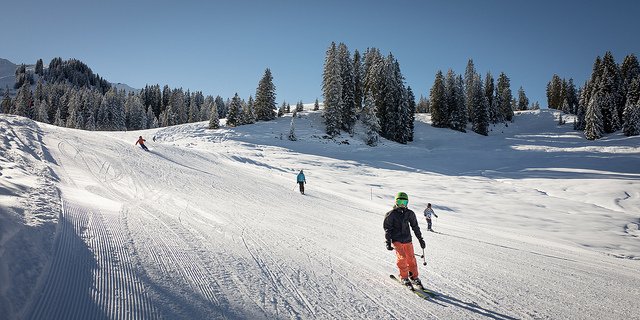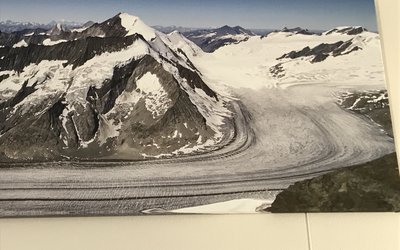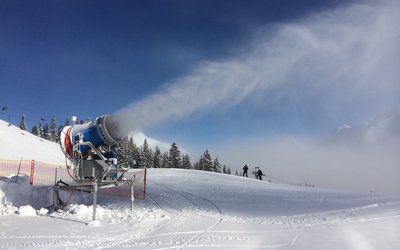
The importance of snow for society
In Switzerland, many alpine towns and villages heavily depend on snow. Up to 90% of their economy is dominated by winter tourism. Besides, like in most mountain regions, melting snow and glaciers in the Alps provide water for heavily populated and farmed areas far downstream even during hot and dry summer months. Swiss hydropower companies use this water to generate a large share of the needed electricity. Snow also has a significant influence on Alpine ecology. Plants and animals in subalpine and alpine ecosystems strongly respond to changes in snow depth and snowmelt timing. Clearly, knowledge on future snowpack changes is of great value for decision-makers, for instance when planning investments for tourist infrastructure, and measures to protect against avalanches, or to protect the environment.
Future snowpack changes: four snow indices
Future snowpack changes in the Swiss Alps were estimated with climate and snowpack models for three future time steps: 1935 (covering the 30-year time slot 2020-2049), 2060 (covering 2045-2074), and 2085 (covering 2070-2099). These projections are based on a mean and high-end scenario of climate change. A distinction was made between low-elevation (below 500 metre), mid-elevation (1000-1700 metre) and high-elevation stations (above 2000 metre). The results were compared with the period 1984-2010 as a reference.
Four snow indices were considered: (1) Mean winter snow depth during December – February; (2) Fraction of winters with continuous snow cover of at least 5 cm during a continuous period of at least 30 days; (3) Number of snow days with at least 5 cm (necessary for sledding or cross-country skiing) and 50 cm (for skiing on rough terrain), respectively; (4) New snow days, defined as the number of days per year with a height of new snow greater than 1 cm.
- Changes in mean winter snow depth. Low-elevation stations show the strongest (relative) reduction in mean winter snow depth: 59% in 2035, 78% in 2060, and 85% in 2085. For mid-elevation stations projected mean reductions are 34% in 2035, 60% in 2060, and 70% in 2085. Moreover, for all studied mid-elevation stations mean winter snow depth is projected to be less than 20 cm toward the end of the century. According to the results, the highest elevation station is least affected by predicted climate change.
- Decrease in continuous snow cover. Low-elevation stations already do not have a continuous snow cover for 30 days in today’s climate. At low elevations, it is likely that winters without any snowfall at all occur toward the end of the century. Most mid-elevation stations show a decrease of continuous snow cover between 4 and 22% in 2035 and between 7 and 30% in 2060. In 2085 half of the studied mid-elevation stations no longer have a continuous snow cover for at least 30 days. The highest elevation station preserves a continuous snow cover even at the end of the century.
- Decrease in snow days. Lowest elevation stations show the highest relative reduction in number of snow days: the number of days with at least 5 cm of snow may on average reduce from 10 days per year today to 1 day per year at the end of this century. On average, low elevations do not experience snow days over 50 cm in today’s climate. For mid-elevation stations the number of days with at least 5 cm of snow reduces by 20, 40, and 60% in 2035, 2060, and 2085, respectively. Mid-elevation stations show strong reductions in the number of snow days over 50 cm: on average these stations are projected to only experience up to 10 snow days >50 cm per year toward the end of the century. In fact, days with high snow depths are already strongly reduced at mid-elevation stations in 2060. At the highest elevation station, however, the number of snow days will still be high for even the high threshold of 50 cm at the end of this century (161 days).
- Decrease in new snow days. For new snow days, the relative reductions are highest at the low-elevation stations, up to 75% in 2085. On average, these low elevations are projected to experience only 2 days with snowfall per year toward the end of the century. At mid-elevation stations relative reductions range between 16-24%, 30-46%, and 41-59% in 2035, 2060, and 2085, respectively. Relative reductions are lowest at the highest elevation station (26% in 2085); at this station, reduction in days with snowfall is highest in absolute numbers (30 in 2085), however.
Impacts on society
The drastic snowpack reductions toward the end of the century have high implications for service providers such as winter tourism, water management, winter road maintenance, or forest management.
- It can be assumed that the rather small ski resorts at mid elevations, which are already endangered today, will disappear in the course of this century. At mid-elevation stations, where most resorts are, the economically important Christmas - New Year period might often not be snow covered anymore.
- Hydropower companies will be affected by the decrease in continuous snow cover and snow depth. Less snow mass will be available for runoff. Peak runoff is projected to shift to earlier in the season, and hydropower electricity production can be increased during the winter season, but will be reduced in summer. This may be advantageous: runoff may become more consistent throughout the year. Some mountain rivers, however, may not be able to maintain a sustained discharge during prolonged dry spells in summer anymore. This may also affect residential zones and agriculture when water demand for irrigation cannot be met.
- One of the main benefits of alpine forests is the protection from natural hazards. In Switzerland, 49% of the total forest area acts as protective forest. Less days with high snow depth means less avalanches in forested terrain. This would imply a change in forest management from avalanche protection to other priority functions such as rock fall or erosion control. In fact, model results indicate that forest management should already adapt to changes that are underway, for instance by planting other tree species.
- Snow and ice can cause major problems for communities due to closed roads or airports. Less snowfall will very likely reduce road accidents, temporary airport closures as well as the costs for winter road maintenance at the end of the century.
Other mountain regions
The results above can be expected to be relevant also for neighbouring Alpine countries and other mountain regions with a similar climate, since this study spans a large altitudinal gradient and different snow-climate zones. One should keep in mind though that these results are based on mean values of a large number of models whereas variability between model results is high, in the order of 30%.
Selection of related articles in the ClimateChangePost:
- Snow cover duration in Swiss Alps has shortened by 9 days per decade since 1970
- Melting glaciers increase water and sediment yields in Alpine watersheds
- The vulnerability of Pyrenean ski resorts to climate change
Source: Schmucki et al., 2017. Theoretical and Applied Climatology 127: 875-889
Photo: Arianta (www.flickr.com)








